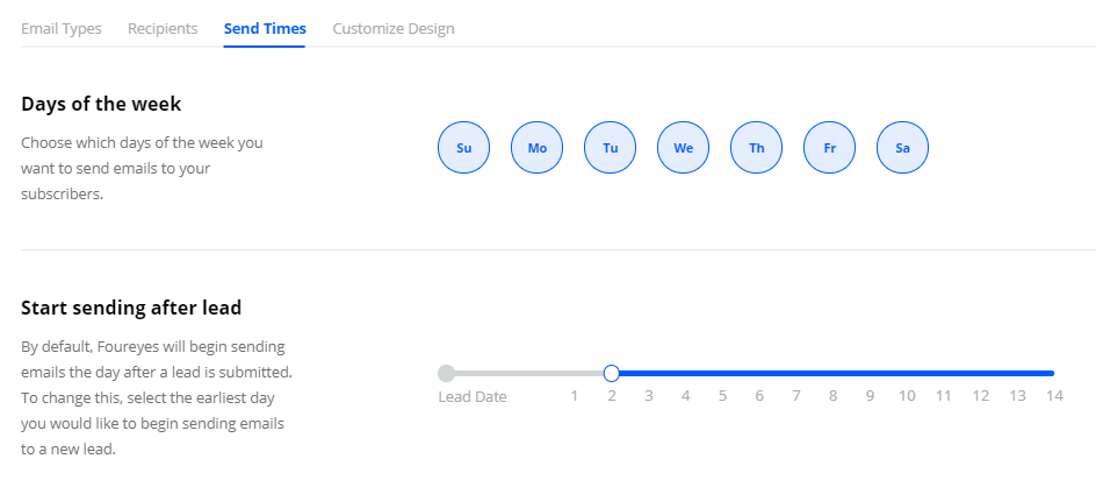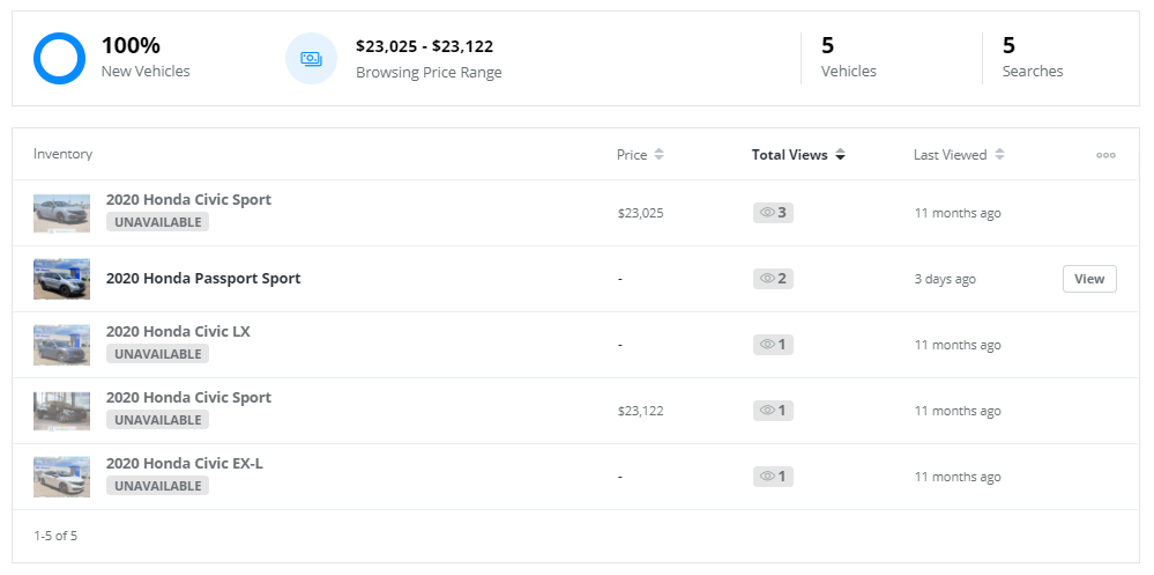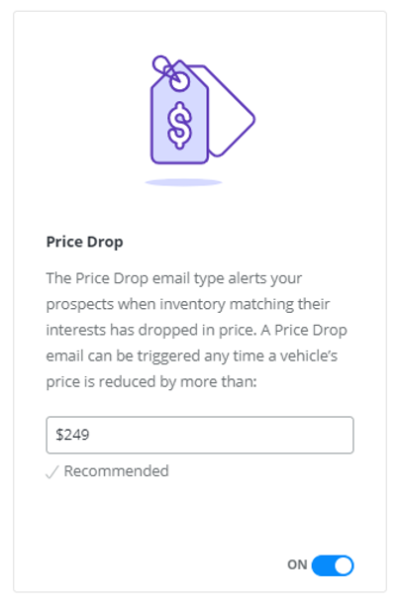
We’re in a time of low inventory and high demand. And for the forward-thinking auto dealer, the lack of inventory is an opportunity to implement positive changes that can create a better buying experience and fend off market disruption. The better we understand what’s really going on in today’s market, the better our decision making and strategic longevity.
I recently hosted a webinar to discuss this topic in-depth. If you’d like to watch the 30-minute session, you can request it through the form below. Or I’ve written up the highlights for any readers out there.
Making Sense of Today’s Market
Our current hypothesis is that because inventory is low, more and more buyers are starting to wait on the sidelines. Inventory shortages were felt first by OEMs, then dealers, and now the problem is becoming more widespread and understood by the consumer.
As more leads change their search criteria based on what’s available or even choose to pause their search for a few months, this change in consumer behavior is a good sign that it’s time for auto dealers to move from a transactional business model to a lifetime value (LTV) business model. When we see buyers choosing to wait 4-6 months to purchase a vehicle, they shouldn’t be written off as lost leads. These buyers will be back in 4-6 months, and it’s what you do in the meantime that will determine whether your dealership is where they’ll return when inventory is back in stock.
Adopting this LTV way of thinking ensures that you are their first option when customers are ready to buy later this year or even early next when inventory levels rise again. But it may require your dealership to make some changes to the retail experience so that your sales process supports a longer path to purchase and all the customers in your pipeline are engaged, regardless of how soon they’re planning to buy.
The first thing you can do, that should always be a top priority, is to improve the prospect experience. Make improvements to your sales process that prioritize the customer experience to ensure that whether they’re buying in 3 days or 3 months from now, you’re who they’re going to purchase from.
The second is to focus on selling aged inventory. No one wants inventory sitting on their lot too long, so make sure you’re not just focused on moving the new inventory that’s in low supply these days, but also have a strategy for used and aged inventory to keep your lot balanced and prevent inventory from overstaying its welcome.
Finally, if you can’t get more new inventory, get more used. We’re seeing dealers approach this in two ways—some are aggressively trying to buy more used inventory, while others are scared of overpaying for used models that will sit on their lots. We don’t know how the next 3-6 months will go and which strategy is better, but we do know that low inventory is a problem for both types of dealerships, so I want to share a few ways that Foureyes can help.
How Foureyes Can Help
Foureyes sales intelligence is made up of four modules that work together or on their own to help inventory-based businesses sell more efficiently and effectively.
- Omni-Tracking: Customer lead tracking that provides visibility into where your leads come from and what they view or do on your website.
- Safety Net: Sales process protection that makes sure your actual sales leads make it into your CRM.
- Prospect Engagement: Sales follow-up technology that automates emails to your leads based on their interests and engagement with your website.
- Sales Enablement: Sales performance tool that helps both managers and salespeople better understand and sell to leads in their pipeline.
Here are a few ways that Foureyes supports an LTV business model and can help dealerships of all sizes with sales challenges specific to low inventory and high demand.
PREVENT LOST LEADS
First, make sure a lead who reaches out doesn’t fall through cracks in your pipeline. (This happens more than you may realize.) Let’s say a prospect calls you. If they interacted with your advertising, it’s likely that phone lead cost you $160. Looking at Foureyes customer data from the month of April, 25.5% of sales calls did not make it into the CRM. If a quarter of your sales calls never made it into your CRM, at $160 a pop, how much would that cost you?
You’ve earned those leads, it’s likely you’ve paid for them, and any that go unlogged are a waste of money and lost sales opportunity. But Safety Net fixes this problem for you. Without having to track down who’s not logging leads or figuring out where the process breakdown is, Safety Net simply catches and logs these leads for you. It’s fully automated and you’ll receive reports of the saved leads, so you can mentally cross this management headache off your list.
IMPROVE THE PROSPECT EXPERIENCE
Prospect Engagement is your best tool to instantly improve the prospect experience. If you’re already using Prospect Engagement, you know it sends dynamic emails that provide customers with personalized inventory updates to keep them engaged and moving closer to the sale.
But you may not realize that there are a few settings you can customize to further improve the customer experience during times of low inventory. First, check your email settings to make sure your ‘Do Not Send To’ preferences are accurate and up-to-date. You can exclude certain CRM statuses, but we sometimes see dealers err on the side of excluding too many customer types. The risk in today’s market is that sales teams simply aren’t following up with leads. They’re too busy, demand is too high for the inventory that’s available, and they’re too focused on the segment of leads that know what they want and are ready to buy now. That’s where Prospect Engagement can help, by following up with all of the active leads in your pipeline. There are probably more than you realize, and you want to make sure Prospect Engagement is fully set up to support you by sending dynamic emails to all relevant CRM statuses.

Next, check the days and timing of Prospect Engagement emails. There’s no reason to turn off certain days, and you should make sure that emails can start sending to leads within one to two days. Again, we sometimes see dealers be more cautious in their settings and only start sending after seven or more days, but there’s really no reason to wait that long. Prospect Engagement emails are unobtrusive inventory and price updates, triggered by customer activity and engagement. Our open and click rates are well above industry averages, and our unsubscribe rate is well below. In today's market especially, you’ll see better performance if emails can be sent seven days a week, and within one day of lead activity.
MOVE FROM TRANSACTIONAL TO LTV
Sales Enablement can really help your dealership make the move from a transactional business model to an LTV model. Sales Enablement provides actionable insights about the leads in your pipeline, with tools for both sales managers and salespeople to better understand and sell to leads.
Use the insights in Sales Enablement to consider the potential lifetime value of each customer. One place to start is the ‘Not Lost’ section. This shows you all the leads that your sales team marked as lost, but who were identified as still being active on your website. If a lead’s activity indicates they’re still interested in purchasing from you, Sales Enablement flags them as ‘not lost’ so you don’t miss out on potential sales. This is the perfect opportunity to test an LTV model because these leads may just need a longer sales cycle. Put these leads back in your pipeline, use Prospect Engagement to nurture them over a longer time, and parlay that into an easier sale weeks or even months from now.
CAPTURE THE SWITCH VEHICLE
Both Prospect Engagement and Sales Enablement can be used for this, by letting you see when customers change preferences and become interested in entirely different inventory.
In Prospect Engagement, sort your prospect list by last click. This will show you the leads who have most recently been active on your website. Then click on their name to see specific insights about each lead, including their complete vehicle interests. You’ll be able to see all the inventory they’ve shown interest in, and whether or not each model is still in stock.

Review all the vehicles they’ve looked at, including the number of times they’ve viewed each vehicle. This will give you a cheatsheet of each lead's interests and allow you to follow up about specific inventory that’s still available. And when leads switch interests, which may be happening more due to limited inventory, this is truly a lifesaver so you don’t write someone off if certain inventory is out of stock.
With Sales Enablement, you’ll get daily emails with this information, so it’s even easier to know when leads switch interests. Use each morning’s insights to drill down into what’s relevant at that moment to make the sale.
SELL THROUGH AGED INVENTORY

Both Prospect Engagement and Sales Enablement can also be used to sell through aged inventory.
In your Prospect Engagement settings, check your price drop threshold. The default is $249, but in this market, you could lower that to as little as $99 to squeeze more engagement from price drop emails. If you want to tee up weekend traffic and appointments, the best day to do price drops is Wednesday. Prospect Engagement will send out price drop emails the next day, and we’ve found that emails sent on Thursdays help ensure busy weekends.
In Sales Enablement, select ‘List by Inventory’ and input specific stock or VIN numbers to review leads who have looked at certain models. If you have aged inventory you’re looking to move, this gives you a list of all possible prospects who you can target.
GENERATE TRADE-INS
Sales Enablement can also help you generate more trade-ins. Using ‘List by Inventory’ again, you can see the leads who have looked at your trade-in page. As you know, people don’t always tell you when they have a trade. In fact, they usually don’t. But Foureyes can see whether a lead has visited the trade-in page and we’ve found that about 95% of people who visit this page do in fact have a vehicle to trade in.
Your prospect list is also a good place to find potential trade-ins. Normally you would filter this list by ‘Qualified Leads’ because you just want to focus on your sales leads, but if you’re focusing on trade-ins you should actually look at ‘All Leads’ and select ‘trade-ins’ under interests. This will show you all prospects who have been to the trade section of your website. Export and use this as a call list to see if any of them are interested in selling you their vehicle.

Lastly, you can add a banner to all Prospect Engagement emails that speaks to your trade in policy and reinforces that you’re looking to buy used inventory. You probably have a lot of customers who have a trade they just haven’t told you about. Be proactive in promoting trade-in offers or incentives as part of your email outreach.
Get Started
If you want to test some of the features available with Prospect Engagement, you can sign up for a 60-day free trial. Or, if you already use and love Foureyes and want to earn some extra cash for your dealership, sign up for our ambassador program for the chance to earn $1,000 for referrals.
No one knows how long the inventory shortages will last, but by moving to an LTV model you can provide a customer experience that works during low inventory, high demand, and well after. If you need help implementing changes like these in your organization or want to chat more about what’s happening in today’s market, get in touch.
